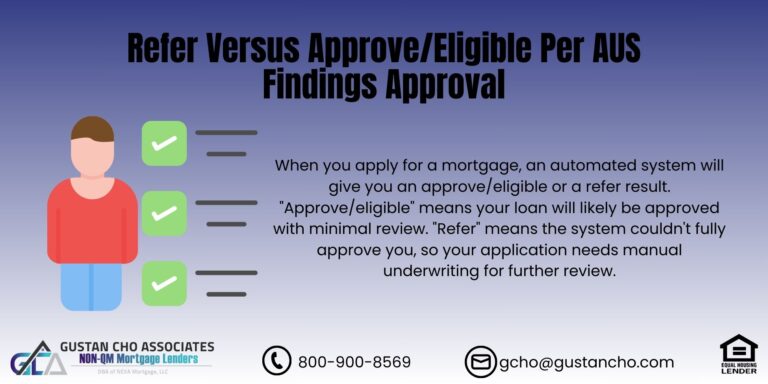Automated Underwriting System Approval: AUS Findings
Automated Underwriting System Approval: Your Fast Track to a Home Loan in 2024
The automated underwriting system approval is a valuable asset that can bring you one step closer to owning your ideal home or refinancing your existing one. Whether buying a new house or looking to lower your mortgage payments, understanding how AUS works is key to getting approved quickly.
In this article, we’ll walk you through everything you need about automated underwriting system approval, including what it is, how it works, and how it can help you get the best mortgage for your needs. By the end, you’ll feel confident in navigating the home loan process in 2024.
Talk To a Loan Officer Click Here
What Is the Automated Underwriting System?
The automated underwriting system (AUS) is a computerized system that mortgage lenders use to assess a borrower’s salary information quickly. AUS can provide instant feedback on whether you will likely be approved for a mortgage. The system analyzes your income, credit, assets, and debts to give a decision on your loan application within minutes.
Mortgage lenders use two main AUS systems:
- Fannie Mae’s Desktop Underwriter (DU)
- Freddie Mac’s Loan Product Advisor (LP)
These systems help lenders determine your eligibility for a mortgage based on your financial situation. Most lenders rely on these systems for government-backed and conventional loans (like FHA, VA, and USDA).
How Does Automated Underwriting System Approval Work?
Automated underwriting system approval is designed to be quick and simple. Here’s what happens:
- You submit your financial information: Your lender will input key details like income, credit score, debts, and assets into the AUS.
- The system analyzes your data: AUS will cross-check your information with the latest lending guidelines. It looks at your credit report, debt-to-income ratio, payment history, and more.
- You get a decision: The system provides one of the following outcomes:
- Approve/Eligible: This means you’re approved and eligible for the loan.
- Refer/Eligible: This means you may qualify, but further review by a human underwriter is needed.
- Refer with Caution: This means more serious issues may prevent loan approval.
Most borrowers aim for the Approve/Eligible status, which allows the loan process to move forward without delays.
Why Automated Underwriting System Approval Matters in 2024

In 2024, the housing market is still competitive, and AUS approval can give you a major advantage. With AUS approval, your loan application is processed faster, increasing your chances of securing a home or locking in a lower interest rate.
Plus, AUS approval ensures you’re meeting the updated guidelines set by agencies like Fannie Mae and Freddie Mac, which continuously evolve to keep up with market changes. For example, recent updates have made it easier for self-employed borrowers to get approved by considering more flexible income documentation.
What Happens if AUS Findings Require Manual Underwriting?
While AUS approval is the fastest route to getting a mortgage, sometimes the system may return a Refer/Eligible result. Although you might meet the basic criteria, additional human review is needed. This is where manual underwriting comes into play.
Manual underwriting is when a human underwriter steps in to review your file in more detail. This is common for borrowers with unique financial situations, such as:
- Credit challenges like past bankruptcies, late payments, or limited credit history.
- Income from non-traditional sources, such as freelancers or small business owners.
- FHA and VA loans, which allow manual underwriting in cases where AUS findings aren’t sufficient.
If your loan goes to manual underwriting, don’t panic! It just means the lender needs a closer look at your financial situation. Many borrowers get approved this way, especially with FHA or VA loans.
What Does the AUS Look at to Make a Decision?
The AUS system is thorough. It examines several factors to determine whether you qualify for a loan. Here’s what it looks at:
- Income: Are you making enough money to cover your mortgage payments?
- Credit Score: Is your credit score strong enough to meet the lender’s requirements?
- Debt-to-Income Ratio (DTI): This measures the proportion of your income allocated to debt repayment. A lower DTI is more favorable.
- Payment History: Have you been paying your bills on time, especially in the last 12 months?
- Assets: Do you have enough savings to cover your down payment and closing costs?
- Public Records: The system checks for bankruptcies, foreclosures, or other negative events that could impact your approval.
In 2024, the AUS system has been updated to reflect more lenient guidelines for borrowers who have faced recent economic challenges. If you’ve worked hard to rebuild your credit or income, you may still qualify for a mortgage even if you have past financial hardships.
Common Reasons AUS Denies a Loan
While AUS can be very efficient in approving loans, it can also flag potential issues that might cause a denial. Here are some common reasons for an AUS denial:
- Low credit score: AUS will flag this as an issue if your credit score doesn’t meet the lender’s minimum requirement.
- High DTI ratio:It is possible that AUS will not approve your loan if your debt is too high in relation to your income.
- Recent late payments: Late payments within the last 12 months can impact your Automated Underwriting System approval.
But don’t lose hope! Sometimes, small adjustments can make a big difference. For example, paying down a credit card or adding a co-borrower with stronger credit could improve your AUS findings. Speak With Our Loan Officer for Mortgage Loans With Low Credit Scores
What to Do If AUS Denies You
If your AUS findings show Refer with Caution or you’re denied, it’s not the end of the road. Here’s what you can do next:
- Ask for manual underwriting: If you’re applying for an FHA or VA loan, ask your lender if manual underwriting is an option.
- Try a different AUS system: Sometimes borrowers are denied by Fannie Mae’s DU but get approved by Freddie Mac’s LP. Your loan officer can rerun your application through the other system.
- Improve your financial profile: Work on paying off debt, increasing your savings, or fixing errors on your credit report. Even small changes can boost your AUS approval chances.
What is Rental Verification in AUS?
One key requirement that can pop up during the automated underwriting system approval process is rental verification. This is when AUS asks for proof that you’ve been paying your rent on time for the past 12 months. This can be a deal-breaker for borrowers who pay rent in cash, as cash payments can’t be verified through canceled checks or bank transfers.
If AUS requests rental verification and you can’t provide proof, the Approve/Eligible status may no longer be valid. However, if you’re renting from a registered property management company, a letter from the property manager might be enough to satisfy this requirement.
If you need help with rental verification, ask your loan officer if they can submit your loan to Freddie Mac’s LP system, which may not require this documentation.
Updated AUS Guidelines for 2024
In 2024, AUS systems have become even more sophisticated, with updated guidelines to make homeownership more accessible. Here are some important updates:
- Flexible income documentation: Self-employed borrowers can now use alternative methods of proving income, like bank statements.
- Credit flexibility: AUS systems may be more forgiving if you’ve recently rebuilt your credit after a financial setback.
- Streamlined processes: AUS now works faster than ever, allowing for quicker approvals and more competitive mortgage rates.
How Long Does Automated Underwriting System Approval Take?
One of the greatest benefits of automated underwriting system approval is how fast it works. Once your loan officer inputs your financial information, the system can generate a decision in seconds. This means you can get pre-approved for a mortgage and move forward with your home search faster than ever.
However, the process might take a bit longer if your application requires manual underwriting or additional documentation. But rest assured, your loan officer will guide you through the steps to get you approved as quickly as possible.
Conclusion: Get Your Automated Underwriting System Approval Today!
Getting an automated underwriting system approval is the first big step in securing a mortgage. Whether you’re buying your first home, refinancing, or investing in real estate, the AUS makes the process fast and easy. By understanding how it works and what lenders look for, you’ll be better prepared to get approved for the home loan you need in 2024.
If you’re ready to take the next step toward homeownership or refinancing, reach out to us today! Our knowledgeable loan officers are available to assist you every step of the way, ensuring you get the best rates and terms available.
Don’t wait—apply now and start your journey to owning your dream home! Contact Non-QM Mortgage Lenders at 800-900-8569 or email us at gcho@gustancho.com.
Frequently Asked Questions About Automated Underwriting System Approval:
Q: What is an Automated Underwriting System (AUS)?
A: An automated underwriting system (AUS) is a computerized tool that mortgage lenders use to quickly evaluate your financial information, like income, credit score, debts, and assets. It helps determine if you’re eligible for a mortgage within minutes.
Q: How Does Automated Underwriting System Approval Work?
A: Your lender enters your financial details into the AUS, which checks them against mortgage guidelines. The system then makes a decision: Approve/Eligible, Refer/Eligible, or Refer with Caution. An Approve/Eligible means you will likely be approved for a loan.
Q: Why is Automated Underwriting System Approval Important in 2024?
A: In 2024, automated underwriting system approval will be more crucial than ever because it speeds up the mortgage process, helping you secure a home faster and potentially locking in lower interest rates in a competitive housing market.
Q: What Happens if I Don’t Get an Automated Underwriting System Approval?
A: Suppose you don’t get an Approve/Eligible. In that case, your loan may go to manual underwriting, meaning a person will review your file more thoroughly. This often happens with FHA or VA loans and can still lead to approval.
Q: Can I Improve my Chances of Getting Automated Underwriting System Approval?
A: Yes! Correcting errors on your credit report, paying off debt, and ensuring your income and assets are properly documented before applying can increase your likelihood of success.
Q: What Does Automated Underwriting System Approval Look at?
A: The AUS evaluates your overall financial health by examining key factors such as your income, credit score, debt-to-income ratio (DTI), payment history, and assets to determine whether you’re eligible for a mortgage.
Q: What if the Automated Underwriting System Requires Rental Verification?
A: If the AUS asks for rental verification, you must show proof of on-time rent payments for the past 12 months. Paying rent in cash might cause issues since cash payments can’t be verified.
Q: How Fast is Automated Underwriting System Approval?
A: Automated underwriting system approval is usually instant. Once your lender submits your information, the system can make a decision in seconds, making the process quick and efficient.
Q: Can I Still Get a Mortgage if the Automated Underwriting System Denies Me?
A: Yes, you can. If the AUS denies your loan, you may still be eligible through manual underwriting. Alternatively, your loan officer can submit your application to a different AUS, like Freddie Mac’s LP.
Q: Are There Any New Updates to the Automated Underwriting System Approval for 2024?
A: Yes! In 2024, there are more flexible income guidelines for self-employed borrowers and more forgiving credit requirements for those who have worked to rebuild their financial standing after a setback.
Speak With Our Loan Officer for Mortgage Loans
This blog about “Automated Underwriting System Approval: AUS Findings” was updated on October 9th, 2024.







